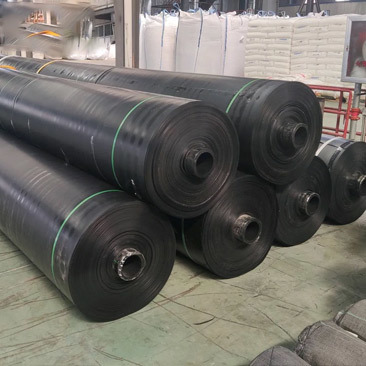Why PE Geomembrane is Essential for Effective Site Drainage
Release time:
2025-09-30
Why PE Geomembrane is Essential for Effective Site Drainage Table of Contents Introduction to PE Geomembranes What is PE Geomembrane? The Importance of Effective Site Drainage Benefits of Using PE Geomembranes Durability and Longevity Cost-Effectiveness Environmental Safety Applications of PE Geomembranes
Why PE Geomembrane is Essential for Effective Site Drainage
Table of Contents
- Introduction to PE Geomembranes
- What is PE Geomembrane?
- The Importance of Effective Site Drainage
- Benefits of Using PE Geomembranes
- Applications of PE Geomembranes
- Installation Techniques for PE Geomembranes
- Maintenance and Monitoring
- Conclusion
- FAQs
Introduction to PE Geomembranes
In the realm of construction and site development, effective drainage is a critical factor for the longevity and stability of any project. **Polyethylene (PE) geomembranes** have emerged as a vital solution for managing water flow effectively. This article delves into why PE geomembranes are indispensable for effective site drainage, covering their properties, benefits, and applications.
What is PE Geomembrane?
PE geomembrane is a type of synthetic liner or barrier made primarily from polyethylene. These geomembranes are engineered to prevent water and other liquids from passing through, making them exceptionally useful in various containment and drainage applications. The **flexibility**, **durability**, and **chemical resistance** of PE geomembranes make them a preferred choice in the construction industry.
The Importance of Effective Site Drainage
Effective site drainage is crucial for several reasons:
1. **Prevention of Water Accumulation**: Standing water can cause structural damage to buildings and roads, leading to costly repairs.
2. **Soil Erosion Control**: Proper drainage systems mitigate soil erosion, which can compromise the integrity of landscapes and infrastructures.
3. **Flood Risk Reduction**: Effective drainage reduces the risk of flooding in low-lying areas, protecting both property and human lives.
4. **Health and Safety**: Poor drainage can lead to stagnant water, which is a breeding ground for pests and diseases.
Benefits of Using PE Geomembranes
PE geomembranes present a multitude of advantages for site drainage systems:
Durability and Longevity
One of the standout features of PE geomembranes is their **exceptional durability**. Manufactured from high-density polyethylene, these geomembranes can withstand extreme weather conditions, UV exposure, and physical stress. This resilience ensures that they maintain their integrity over time, providing reliable service for years.
Cost-Effectiveness
When it comes to budget considerations, PE geomembranes offer **cost-effective solutions**. Their longevity reduces the need for frequent replacements, which can significantly lower long-term expenditures. Additionally, their installation can be completed quickly and efficiently, minimizing labor costs.
Environmental Safety
PE geomembranes are environmentally friendly. They do not leach harmful chemicals into the soil or waterways, making them suitable for use in sensitive environmental areas. Their ability to contain and manage water runoff helps protect natural ecosystems from contamination.
Applications of PE Geomembranes
PE geomembranes find extensive applications across various sectors:
Landfills
In landfill management, PE geomembranes are utilized as liners to prevent leachate from polluting surrounding soil and groundwater. This containment is vital for maintaining environmental safety and compliance with regulatory standards.
Ponds and Lakes
For artificial ponds and lakes, PE geomembranes serve as liners that prevent water loss due to seepage. This application is critical for water conservation and maintaining the aesthetic and ecological value of these water bodies.
Road Construction
In road construction, PE geomembranes are employed to manage surface water runoff. By directing water flow away from roadways, they help prevent erosion and structural damage, ensuring the longevity of the roadway.
Installation Techniques for PE Geomembranes
Installing PE geomembranes requires careful planning and execution:
1. **Site Preparation**: Before installation, the site must be cleared of debris and sharp objects that could puncture the geomembrane.
2. **Laying the Geomembrane**: The geomembrane should be laid out flat to avoid wrinkles. Overlapping seams should adhere to the manufacturer's specifications.
3. **Seaming Techniques**: Seams can be joined using various methods, including thermal welding or adhesive bonding, ensuring a watertight seal.
4. **Inspection**: After installation, a thorough inspection is necessary to identify any potential issues that could compromise the system's integrity.
Maintenance and Monitoring
To ensure the continued effectiveness of PE geomembranes, regular maintenance and monitoring are essential:
- **Visual Inspections**: Routine checks for damages or wear can help identify issues before they escalate.
- **Repairing Damage**: Any punctures or tears should be repaired promptly using appropriate materials to restore the geomembrane's functionality.
- **Monitoring Water Movement**: Keeping tabs on water flow patterns can provide insights into how well the drainage system is performing, allowing for timely adjustments.
Conclusion
In conclusion, PE geomembranes are essential for effective site drainage systems. Their durability, cost-effectiveness, and environmental safety make them an invaluable asset in construction and landscaping projects. By investing in PE geomembranes, stakeholders can ensure the longevity and stability of their sites while safeguarding against water-related issues.
FAQs
1. What is the lifespan of a PE geomembrane?
The lifespan of a PE geomembrane typically ranges from 20 to 30 years, depending on environmental conditions and proper maintenance.
2. Can PE geomembranes be recycled?
Yes, many PE geomembranes can be recycled, contributing to environmental sustainability.
3. Are there specific regulations governing the use of PE geomembranes?
Yes, various regulations apply depending on the application and location. It's essential to consult local guidelines.
4. How do I choose the right thickness for a PE geomembrane?
The appropriate thickness depends on the specific application, potential stress, and environmental factors. Consulting with a specialist can help determine the best choice.
5. Can PE geomembranes be used in cold climates?
Yes, PE geomembranes are versatile and can be used in various climates, provided installation procedures account for temperature variations.






